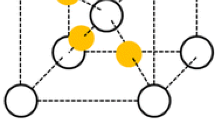Abstract
CdS is the most matching window material available for the CdTe absorber layer of CdS/CdTe solar cells and electrodeposition is a promising technique adaptable for fabrication of thin films of CdS owing to its simplicity, low cost, scalability and manufacturability. The quality of electrodeposited thin film semiconductor layers depends significantly on the electrodeposition potential, concentrations of precursor salts, pH, temperature and the rate of stirring of the electrolyte. In this study, the attention was focused on the effect of “stirring rate of electrolyte” since it has not been studied in detail in the past, despite of its strong relation to the rate of mass transport towards the working electrode where the thin film semiconductors are electrodeposited. This study was carried out via electrodepositing of CdS thin layers on fluorine doped tin oxide conducting glass working electrodes at different rates of stirring of the electrolyte while keeping the rest of the electrodeposition parameters unchanged at a previously identified set of values. The morphological, electrical and optical properties of the CdS layers grown at different stirring rates were used to determine the effect of stirring rate on the quality of CdS layers. The study revealed that, a stirring rate in the range of 60–125 rpm which produced orderly flows in the electrolyte around the working electrode (1 × 3 cm2) placed at the center of a 100 ml electrolytic bath with a distance of 2 cm apart between the graphite counter electrode and the conducting glass electrode could produce good quality CdS layers when electrodeposition was carried out at a cathodic deposition potential of 660 mV with respect to the saturated calomel electrode. The concentrations of CdCl2 and Na2S2O3 in the bath used were 0.10 and 0.01 M respectively. The temperature and pH of it were 60 °C and 1.80 respectively.







Similar content being viewed by others
References
R.W. Miles, K.M. Hynes, I. Forbes, Photovoltaic solar cells: an overview of state-of-the-art cell development and environmental issues. Prog. Cryst. Growth Charact. Mater. 51(1–3), 1–42 (2005)
S. Nagalingam, Cyclic voltammetry studies of cadmium zinc sulfide aqueous solution. Afr. J. Bus. Manag. 6(31), 7166–7170 (2011)
I.M. Dharmadasa, J. Haigh, Strengths and advantages of electrodeposition as a semiconductor growth technique for applications in macroelectronic devices. J. Electrochem. Soc. 153(1), G47 (2006)
S.K. Das, Characterisation of CdCl2 treated electrodeposited CdS/CdTe thin film solar cell. Sol. Energy Mater. Sol. Cells 29(3), 277–287 (1993)
D.H. Rose, F.S. Hasoon, R.G. Dhere, D.S. Albin, R.M. Ribelin, X.S. Li, Y. Mahathongdy, T.A. Gessert, P. Sheldon, Fabrication procedures and process sensitivities for CdS/CdTe solar cells. Prog. Photovoltaics Res. Appl. 7(5), 331–340 (1999)
S. Chun, K.S. Han, J.S. Lee, H.J. Lim, H. Lee, D. Kim, Fabrication CdS thin film and nanostructure grown on transparent ITO electrode for solar cells. Curr. Appl. Phys. 10(2 SUPPL.), S196–S200 (2010)
K. Zarȩbska, M. Skompska, Electrodeposition of CdS from acidic aqueous thiosulfate solution-invesitigation of the mechanism by electrochemical quartz microbalance technique. Electrochim. Acta 56(16), 5731–5739 (2011)
F. Kadirgan, D. Mao, W. Song, T. Ohno, B. Mccandless, Properties of electrodeposited cadmium sulfide films for photovoltaic devices with comparison to CdS. Turk. J. Chem. 24, 21–33 (2000)
S. Dennison, Studies of the cathodic electrodeposition of CdS from aqueous solution. Electrochim. Acta 38(16), 2395–2403 (1993)
M. Rostami, R. Ebrahimi-Kahrizsangi, A. Saatchi, Influences of bath stirring rate on synetics of nano composite Ni–SiC–Gr coatings on St37 via electrodeposition process. J. Adv. Mater. Process. 1(2), 11–19 (2012)
D.G. Diso, G.E.A. Muftah, V. Patel, I.M. Dharmadasa, Growth of CdS layers to develop all-electrodeposited CdS/CdTe thin-film solar cells. J. Electrochem. Soc. 157(6), H647 (2010)
I.M. Dharmadasa, Review of the CdCl2 treatment used in CdS/CdTe thin film solar cell development and new evidence towards improved understanding. Coatings 4(2), 282–307 (2014)
I.M. Dharmadasa, P. Bingham, O. Echendu, H. Salim, T. Druffel, R. Dharmadasa, G. Sumanasekera, R. Dharmasena, M. Dergacheva, K. Mit, K. Urazov, L. Bowen, M. Walls, A. Abbas, Fabrication of CdS/CdTe-based thin film solar cells using an electrochemical technique. Coatings 4(3), 380–415 (2014)
S. Chun, Y. Jung, J. Kim, D. Kim, The analysis of CdS thin film at the processes of manufacturing CdS/CdTe solar cells. J. Cryst. Growth 326(1), 152–156 (2011)
U. Madhu, N. Mukherjee, N.R. Bandyopadhyay, A. Mondal, Properties of CdS and CdTe thin films deposited by an electrochemical technique. Indian J. Pure Appl. Phys. 45(3), 226–230 (2007)
Acknowledgments
Authors would like to acknowledge the University Grants Commission and National Research Council, Sri Lanka for their financial support under the UGC Innovative Grant and the NRC grant 06-60 respectively.
Author information
Authors and Affiliations
Corresponding author
Rights and permissions
About this article
Cite this article
Atapattu, H.Y.R., De Silva, D.S.M., Pathiratne, K.A.S. et al. Effect of stirring rate of electrolyte on properties of electrodeposited CdS layers. J Mater Sci: Mater Electron 27, 5415–5421 (2016). https://doi.org/10.1007/s10854-016-4443-3
Received:
Accepted:
Published:
Issue Date:
DOI: https://doi.org/10.1007/s10854-016-4443-3




